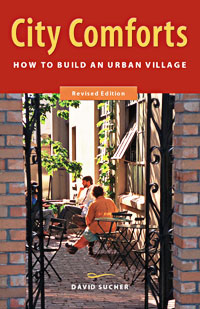Speaking of Urban Design, City Comforts, and the idea of the book group

City Comforts is a great, profusely illustrated book about revitalizing city neighborhoods. The author, David Sucher, has created a companion blog which is just as great as the book. (I wish I could spend more time reading blogs, but I can't even get through a day's email.)
In the blog, he has provided an excerpt from the book, to explain what he refers to as "The Three Rules":
This is the most important chapter in this book. If the problem is to create a walkable, pedestrian-oriented neighborhood, much of the answer is architectural. Actually, it is not so much “architectural” in the usual sense of the word, for it ignores style. Site plan trumps architecture. That means the basic arrangement of the building on the site is far more important than what usually passes for architecture: the exterior appearance and “envelope” of the structure.
This chapter explains the Three Rules for creating such places. Let’s assume that we agree that the goal is to create this mythical urban village. How do we do it?
The key decision is the position of the building with respect to the sidewalk. This decision determines whether you have a city or a suburb.
Rule 1: Build to the sidewalk (i.e., property line)
Rule 2: Make the building front “permeable” (i.e., no blank walls)
Rule 3: Prohibit parking lots in front of the building
Maybe City Comforts should be one of the earlier books to read in the proposed "book group" that I mentioned in this blog entry last week.



0 Comments:
Post a Comment
<< Home